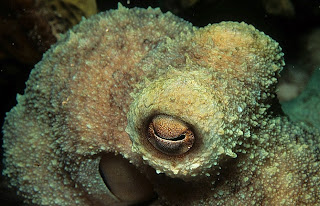 Awhile back I mentioned that I have a 'thing' for photographing the faces and eyes of creatures in the sea. If you've been following along, you've already seen the conch shell's eyes, and the cross-eyed cone shell. Here are a couple more portraits of critters' eyes.
Awhile back I mentioned that I have a 'thing' for photographing the faces and eyes of creatures in the sea. If you've been following along, you've already seen the conch shell's eyes, and the cross-eyed cone shell. Here are a couple more portraits of critters' eyes.The creature in the first photo, at right, is a Caribbean Reef Octopus (Octopus briareus). You can click on the photos for a larger view.
In addition to his eyes, take note of his amazing skin. That skin can change from a dark reddish color to the almost iridescent green of the specimen in this photo -- and almost every shade in between. This octopus (like many others) also can change the texture of its skin from smooth to rough in order to blend in with its surroundings.
 Finding that octopus was a stroke of luck. The Caribbean Reef Octopus almost always hides in its lair during the day, so the only time a diver is likely to come across one is at night. Indeed, the individual in the photo above was encountered during a night dive at a place called Radar Reef on the north shore of Cayman Brac.
Finding that octopus was a stroke of luck. The Caribbean Reef Octopus almost always hides in its lair during the day, so the only time a diver is likely to come across one is at night. Indeed, the individual in the photo above was encountered during a night dive at a place called Radar Reef on the north shore of Cayman Brac.This next eyeball, on the left, belongs to a Blue-spotted Stingray (Taeniura lymma), one of the most easily recognizable of stingray species for obvious reasons. The first time you see one at close range, you can hardly believe your eyes. Those blue spots are quite dazzling.
Blue-spotted Stingrays are quite abundant in the Red Sea. That's where this one was photographed. It was resting on the sand at Ras Mohammed, near the southern tip of the Sinai peninsula. I approached it inch by inch, trying my best not to startle it so that I could get this macro shot of its eye.
 This second photo of a Blue-spotted Stingray also was taken in the Red Sea. I'm including it here so that you can have a better idea of what the whole animal looks like.
This second photo of a Blue-spotted Stingray also was taken in the Red Sea. I'm including it here so that you can have a better idea of what the whole animal looks like.What's missing from this photo, of course, is the stingray's tail. By the way, yes these animals do have a venomous stinger, but contrary to popular belief, it's not in the end of the tail, and they don't slash their tails around to try to sting prey -- or divers. The stinger -- actually a spine with a barb on the end -- is at the base of the tail.
They're quite shy and often swim away when a diver approaches. They look very pretty when they swim, because they propel themselves through the water by fluttering the edges of their body.
Blue-spotted Stingrays are one of the smaller species of stingray. To give you an idea of their size, the ones in the photos on this page were about one foot (30cm) in diameter.

BNSullivan.jpg)
BNSullivan.jpg)
BNSullivan.jpg)

BNSullivan.jpg)
BNSullivan465x300.jpg)
BNSullivan.jpg)
BNSullivan.jpg)

Incredible shots, the blue spots on the stingray are awesome, you must be having a blast getting these shots.
ReplyDeleteI had no idea that the octopus could disguise itself so well. And the blue dots on the stingray are just awesome!
ReplyDeleteThank you for sharing your finds with everyone.
There's nothing quite like those eye-catching blue spots!
ReplyDelete@ Bernie - Yes, a lot of fun, but a lot of work, too!
@ HVG - The octopus is known for made-to-order disguises, not just the kind in the photo here, but the 'tako' that we have here in Hawaii, too.
Bobbie
The blue in the stingray is just beautiful. Those octopus, on the other hand, they really give me the creeps - all those suction cups and their sly little tricks. My friend had beautiful aquariums filled with all kinds of fish, and one of them had an octopus in it. Each morning she would notice a fish gone from one of the other tanks. Come to find out, that octopus was leaving his own tank during the night and going into the others and eating the fish.
ReplyDeleteHi kml - Your story about the octopus and your friend's aquarium definitely rings true. Any diver who has spent time watching these creatures under water knows that they are really quite smart and very crafty. Same goes for their cousins, the squids! On more than one occasion we've spent an entire dive just watching them.
ReplyDeleteBobbie
Beautiful shots, just beautiful. And I like what you say about photographing their eyes; it seems like the best shots of any living creature show their eyes, which makes us wonder what's on their minds....
ReplyDeleteDale -
ReplyDeleteThanks for your comment. I agree, the eyes are the most important feature to capture in an image of a living creature.
Bobbie
This is really a great site. WOW. Good stuff.
ReplyDeleteHi Mike -
ReplyDeleteThank you. I like your Montauk Point blog, too -- also "good stuff." ;-}
Bobbie
Great Pictures!!! Do you know if stingrays can see colors??
ReplyDeleteSorry, I do not know if stingrays have color vision.
ReplyDeleteBobbie